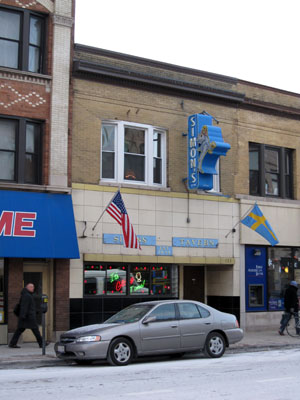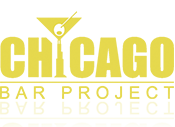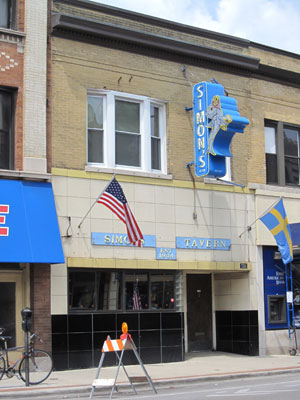 Fish drinking martinis, glögg, Viking paraphernalia, ancient Schlitz advertising, and Swedish roots make Simon’s not only an excellent neighborhood bar but also an interesting experience for anyone that steps within its friendly environs. Since the Depression, Simon’s has anchored this part of Clark Street, just north of Foster, in the Swedish enclave of Andersonville. Simon’s compliments the unique character of other Swedish neighborhood staple establishments, such as Wikstrom’s Gourmet Foods and the original location of Ann Sather’s, while also fitting in well with non-Swedish Andersonville newcomers like Hopleaf, Reza’s, Jin Ju, and even Starbucks. With its long and intriguing history and personality, Simon’s also holds its own when compared with other Chicago neighborhood drinking institutions like John Barleycorn’s, Emmit’s Pub, Charleston, and Glascott’s Groggery.
Fish drinking martinis, glögg, Viking paraphernalia, ancient Schlitz advertising, and Swedish roots make Simon’s not only an excellent neighborhood bar but also an interesting experience for anyone that steps within its friendly environs. Since the Depression, Simon’s has anchored this part of Clark Street, just north of Foster, in the Swedish enclave of Andersonville. Simon’s compliments the unique character of other Swedish neighborhood staple establishments, such as Wikstrom’s Gourmet Foods and the original location of Ann Sather’s, while also fitting in well with non-Swedish Andersonville newcomers like Hopleaf, Reza’s, Jin Ju, and even Starbucks. With its long and intriguing history and personality, Simon’s also holds its own when compared with other Chicago neighborhood drinking institutions like John Barleycorn’s, Emmit’s Pub, Charleston, and Glascott’s Groggery.
A Woman Needs a Man Like a Fish Needs a… Martini?
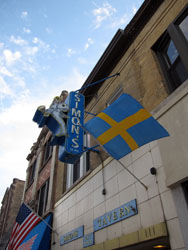 Since 1934, Simon’s bright blue and yellow neon sign depicting a fish holding a martini has been a beacon in the night for Andersonville residents and an increasing number of others exploring this hip enclave. The fish turns out to be a double entendre – “pickled herring” – which is a delicacy in Sweden. Get it? Right… The façade was created in the art deco style, and is comprised also of yellow and blue ceramic tile (the color of the Swedish flag), and glass blocks frame the front window, lined with blue Christmas lights. Step through the battered wooden door and you’ll find a long barroom. Both the façade and design of the bar was inspired by the triple-stacked French steamship, S.S. Normandie, once the world’s largest ocean liner back in the 1930s. Because travel on the Normandie was too expensive for the average clientele of Simon’s at the time, the bar instead was designed to give the feel of being on that ship (for a much lower price, of course). An image of the Normandie can be found etched into each mirror behind the cash registers and below the Swedish and Norwegian flags behind the bar, and all surfaces of the long, worn mahogany bar that runs most of the length of the southern wall are curved. Blue backlit portholes glow from the bar’s wooden backdrop below a yellow stucco wall (ala Farragut’s up the street and Durkin’s), and an interesting array of Viking paraphernalia that includes: statues, a horned helmet, a shield, an axe, Viking ships, wooden carvings, and a small Viking warrior skewering a bowling pin with what looks like a trident. While I’m not completely sure, I think this makes Simon’s the only bar in Chicago with an axe on display, although Monk’s Pub displays implements of torture (other than axes), and Grizzly’s Lodge has a large wooden mallet hanging over the bar. The Viking helmet is particularly notable for two reasons. Firstly, the Vikings did not wear helmets, let alone helmets with horns on them. Secondly, Simon’s has an ongoing, unadvertised bar contest: if you can spot the five hidden animals in the lodge mural across from the bar, you can drink for free during the entire evening while wearing the helmet.
Since 1934, Simon’s bright blue and yellow neon sign depicting a fish holding a martini has been a beacon in the night for Andersonville residents and an increasing number of others exploring this hip enclave. The fish turns out to be a double entendre – “pickled herring” – which is a delicacy in Sweden. Get it? Right… The façade was created in the art deco style, and is comprised also of yellow and blue ceramic tile (the color of the Swedish flag), and glass blocks frame the front window, lined with blue Christmas lights. Step through the battered wooden door and you’ll find a long barroom. Both the façade and design of the bar was inspired by the triple-stacked French steamship, S.S. Normandie, once the world’s largest ocean liner back in the 1930s. Because travel on the Normandie was too expensive for the average clientele of Simon’s at the time, the bar instead was designed to give the feel of being on that ship (for a much lower price, of course). An image of the Normandie can be found etched into each mirror behind the cash registers and below the Swedish and Norwegian flags behind the bar, and all surfaces of the long, worn mahogany bar that runs most of the length of the southern wall are curved. Blue backlit portholes glow from the bar’s wooden backdrop below a yellow stucco wall (ala Farragut’s up the street and Durkin’s), and an interesting array of Viking paraphernalia that includes: statues, a horned helmet, a shield, an axe, Viking ships, wooden carvings, and a small Viking warrior skewering a bowling pin with what looks like a trident. While I’m not completely sure, I think this makes Simon’s the only bar in Chicago with an axe on display, although Monk’s Pub displays implements of torture (other than axes), and Grizzly’s Lodge has a large wooden mallet hanging over the bar. The Viking helmet is particularly notable for two reasons. Firstly, the Vikings did not wear helmets, let alone helmets with horns on them. Secondly, Simon’s has an ongoing, unadvertised bar contest: if you can spot the five hidden animals in the lodge mural across from the bar, you can drink for free during the entire evening while wearing the helmet.
“This is the way a tavern used to be—no ferns, glass or peppy waitresses”
– Ethnic Chicago (1993)
The Golden Rule
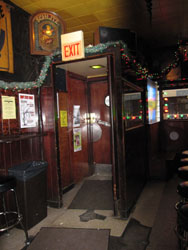 Here at the bar, only one rule has been established for the bartenders: no sitting. If tired, the bartenders are instructed to lean against something. While usually effective because of its simplicity and practicality, the rule eventually had to be broken. Simon’s once employed what was described to me as, “the laziest bartender known to man.” In an attempt to grossly violate this one single rule, the bartender had a regular hand him a stool from the other side of the bar. In doing so, the bartender accidentally shattered one of the three blue, gel capsule-like lights hang from chains over the bar. This was particularly disturbing not only because of the bartender’s aforementioned laziness, but also because the lights were salvaged from Ebenezer Lutheran Church and were so old that the union stickers inside were actually affixed by tar instead of glue. They don’t make ’em like that anymore.
Here at the bar, only one rule has been established for the bartenders: no sitting. If tired, the bartenders are instructed to lean against something. While usually effective because of its simplicity and practicality, the rule eventually had to be broken. Simon’s once employed what was described to me as, “the laziest bartender known to man.” In an attempt to grossly violate this one single rule, the bartender had a regular hand him a stool from the other side of the bar. In doing so, the bartender accidentally shattered one of the three blue, gel capsule-like lights hang from chains over the bar. This was particularly disturbing not only because of the bartender’s aforementioned laziness, but also because the lights were salvaged from Ebenezer Lutheran Church and were so old that the union stickers inside were actually affixed by tar instead of glue. They don’t make ’em like that anymore.
Editor’s note: since this story was initially published, new information has been submitted by T.M.:
I don’t know where you got that story about the broken lamp, but some facts are wrong. I was present the night it was broken some six years ago, and while it is true the lamp was broken by a bar stool being passed over to the back of the bar, the bartender was a female, who, while not being remembered as ‘the laziest bartender known to man,’ will more likely simply not be remembered as a particularly good bartender, which she of course wasn’t. Also, the blue glass diffuser in question has been replaced.”
Beyond the bar lies a small lounge area, complete with two of your grandmother’s worn couches in the back, sans plastic, along with black & white pictures of a parade and a shuffleboard scene, and a red-brick fireplace that warms chilly patrons. Illuminating the “back room” is a stained glass window depicting two crowned and “pickled” herrings (drinking martinis) with little Swedish flags in the corners, backlit with light coming from the room behind.
Pripp’s and Glögg and Schlitz, Oh My
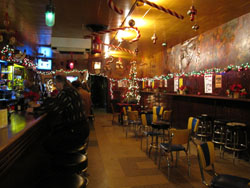 While paling in comparison to the impressive selection of ales just down the block at Hopleaf, Simon’s makes up for it by offering a few unlikely selections. A white placard behind the bar announces that the Swedish “Pripp’s Lager” is available. Pripp’s is a good hoppy brew, though not too bitter, that comes in a blue bottle with the smallest neck I’ve ever seen. And, as any Swedish eatery or drinkery worth its salt, Simon’s serves glögg, both in its intended hot form in winter and as a slushy drink (or on the rocks) in summer, kind of like a Swedish Margarita. If you’re unfortunate enough to never have had glögg, you should know that it is made from a combination of hot port wine blended with raisins, aquavit (Swedish vodka) and other spices, and that it is too good not to try. You’ll thank me later. (If you’re further south, you can also find glögg at Gallery Cabaret in Bucktown). Simon’s also serves Schlitz, as evidenced from the Schlitz stained glass over the door, the bronze Schlitz statue of a Greek goddess holding a lighted Schlitz globe (like at the Green Mill) at the east end of the bar, and weekly specials on this oft misunderstood brew (formerly the biggest selling beer in the US before Budweiser took its crown). The Schlitz statue compliments the array of bronze cherubs that hang from both ends of the bar; the original owner couldn’t bear taking them down after originally hanging them up as Christmas decorations.
While paling in comparison to the impressive selection of ales just down the block at Hopleaf, Simon’s makes up for it by offering a few unlikely selections. A white placard behind the bar announces that the Swedish “Pripp’s Lager” is available. Pripp’s is a good hoppy brew, though not too bitter, that comes in a blue bottle with the smallest neck I’ve ever seen. And, as any Swedish eatery or drinkery worth its salt, Simon’s serves glögg, both in its intended hot form in winter and as a slushy drink (or on the rocks) in summer, kind of like a Swedish Margarita. If you’re unfortunate enough to never have had glögg, you should know that it is made from a combination of hot port wine blended with raisins, aquavit (Swedish vodka) and other spices, and that it is too good not to try. You’ll thank me later. (If you’re further south, you can also find glögg at Gallery Cabaret in Bucktown). Simon’s also serves Schlitz, as evidenced from the Schlitz stained glass over the door, the bronze Schlitz statue of a Greek goddess holding a lighted Schlitz globe (like at the Green Mill) at the east end of the bar, and weekly specials on this oft misunderstood brew (formerly the biggest selling beer in the US before Budweiser took its crown). The Schlitz statue compliments the array of bronze cherubs that hang from both ends of the bar; the original owner couldn’t bear taking them down after originally hanging them up as Christmas decorations.
While Simon’s is one of the few bars in all of Chicago that doesn’t have a Golden Tee machine, a pool table or a kitchen (although beer nuts are available behind the bar, and frozen pizzas and chili upon request), entertainment can be had from live bands like the New Invaders every Sunday (previously The Websters and Love Kit) and singer-guitarist Tykie, an eccentric local celebrity, plays songs and tells jokes on the first Thursday of every month. How’s that for a run-on sentence?
“It’s as comfortable and friendly as a pair of bunny slippers”
– Shecky’s Bar, Club & Lounge Guide 2002
The Deer Hunter(s)
Across from the bar is a smattering of low-slung tables and stools, and a wooden shelf to rest your beer or head upon. Above the shelf are two adjacent murals: one of a deer hunting scene in a forest next and one of deer hunters celebrating their kills in a lodge, both lit by track lighting. Both were painted by neighborhood regular Sig Olsen, and the lodge scene was reproduced from a photograph taken in the 1950s at the Northwoods Inn in Northern Wisconsin (not to be confused with Will’s Northwoods Inn in Chicago), and is called, “The Deer Hunter’s Ball.” The deer hunters depicted in this mural include the original owner, Simon Lundberg, under the accordion player, his son Roy, and other regulars from Simon’s. These regulars were working class Swedes from the neighborhood who loved deer hunting as much as their glögg. The section of the lodge scene that is shriveled and hangs in flaps as if someone had set it on fire, originally depicted a regular who didn’t like how he was painted, so the artist cut his portrait out and repainted – or at least that’s the story they tell…
Simon Lundberg: the Man, the Legend
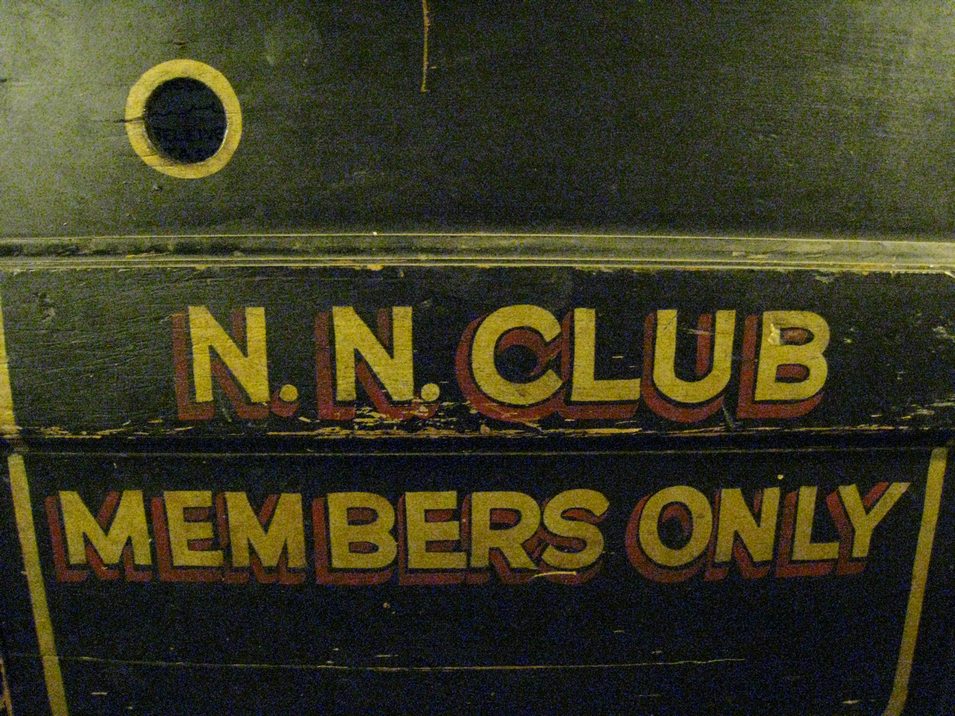 The colorful history of Simon’s Tavern revolves around Simon Lundberg, the original owner and namesake of the bar, whose portrait hangs over the well-stocked jukebox and whose likeness is also featured in the mural. Lundberg emigrated from Sweden in the early 20th Century and became a citizen by fighting for the U.S. in World War I. After the war, he opened a small grocery store called the Burwood Food Shop (now Ranalli’s of Andersonville) and, during Prohibition, received a “proposal” by local bootleggers (that presumably could not be refused) to sell whiskey with his coffee. Lundberg agreed and started making more money selling “coffee” than food – so much so, that he could afford to buy a new and bigger place at the tavern’s current address. The building was previously a bakery run by Olof Hermanson, but Lundberg transformed it into his second grocery store and moved his family in upstairs. For the locals who didn’t care for all the coffee mixed with their whiskey, a speakeasy was run out of the basement called the “N.N. Club” or “No Name Club” (instead of the “No Norwegians Club” as some claim…), and this drinking den even had its own entrance directly accessible from the alley. Here in the NN Club, neighborhood Swedes would sit at long tables, drink whiskey and perhaps would even speak to each other… Once Prohibition ended, Lundberg transformed the grocery into Simon’s Tavern, and remodeled in the afore-mentioned art deco style.
The colorful history of Simon’s Tavern revolves around Simon Lundberg, the original owner and namesake of the bar, whose portrait hangs over the well-stocked jukebox and whose likeness is also featured in the mural. Lundberg emigrated from Sweden in the early 20th Century and became a citizen by fighting for the U.S. in World War I. After the war, he opened a small grocery store called the Burwood Food Shop (now Ranalli’s of Andersonville) and, during Prohibition, received a “proposal” by local bootleggers (that presumably could not be refused) to sell whiskey with his coffee. Lundberg agreed and started making more money selling “coffee” than food – so much so, that he could afford to buy a new and bigger place at the tavern’s current address. The building was previously a bakery run by Olof Hermanson, but Lundberg transformed it into his second grocery store and moved his family in upstairs. For the locals who didn’t care for all the coffee mixed with their whiskey, a speakeasy was run out of the basement called the “N.N. Club” or “No Name Club” (instead of the “No Norwegians Club” as some claim…), and this drinking den even had its own entrance directly accessible from the alley. Here in the NN Club, neighborhood Swedes would sit at long tables, drink whiskey and perhaps would even speak to each other… Once Prohibition ended, Lundberg transformed the grocery into Simon’s Tavern, and remodeled in the afore-mentioned art deco style.
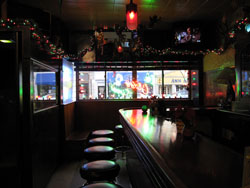 In addition to being a bar, Simon’s also served as a place for Swedish laborers in the neighborhood to cash their checks on payday. Many were fearful of keeping cash in a bank account, considering the stock market crash in 1929, and other check cashing services charged a percentage of each check cashed. Simon charged nothing for his service because most of the cash doled out found its way straight back into Simon’s as it was promptly drunk away to wash down the free buffet that Lundberg served on Friday paydays. $14,000 in checks per week were cashed back then, in a small room under the stairs where a steel door (three inches thick) with bulletproof glass can still be found today. While Simon was working inside his check-cashing room, he would pull a wire that would signal his wife upstairs to bring more money down and the checks were exchanged for cash through a slot in the stairs. Simon also had a system to get himself out of trouble if someone tried to rob him. He would drop a roll of quarters through a small circular hole in the wooden floor that would alert the Swedish masons and bricklayers playing cards below that he needed help. These Swedes would run up the stairs and take care of the situation at hand. Though a robust system, the place was in fact robbed twice according to my friends at the Chicago History Museum – once in 1937 by three gunmen ($875 stolen), and once in 1958 by three masked bandits who forced the bartenders to lie on the ground and 25 patrons told to place hands on bar – $1510 from cash register was stolen, just an hour before it was used to cash paychecks. No robberies have taken place since then, as the check-cashing operation no longer operates.
In addition to being a bar, Simon’s also served as a place for Swedish laborers in the neighborhood to cash their checks on payday. Many were fearful of keeping cash in a bank account, considering the stock market crash in 1929, and other check cashing services charged a percentage of each check cashed. Simon charged nothing for his service because most of the cash doled out found its way straight back into Simon’s as it was promptly drunk away to wash down the free buffet that Lundberg served on Friday paydays. $14,000 in checks per week were cashed back then, in a small room under the stairs where a steel door (three inches thick) with bulletproof glass can still be found today. While Simon was working inside his check-cashing room, he would pull a wire that would signal his wife upstairs to bring more money down and the checks were exchanged for cash through a slot in the stairs. Simon also had a system to get himself out of trouble if someone tried to rob him. He would drop a roll of quarters through a small circular hole in the wooden floor that would alert the Swedish masons and bricklayers playing cards below that he needed help. These Swedes would run up the stairs and take care of the situation at hand. Though a robust system, the place was in fact robbed twice according to my friends at the Chicago History Museum – once in 1937 by three gunmen ($875 stolen), and once in 1958 by three masked bandits who forced the bartenders to lie on the ground and 25 patrons told to place hands on bar – $1510 from cash register was stolen, just an hour before it was used to cash paychecks. No robberies have taken place since then, as the check-cashing operation no longer operates.
Following the death of Simon Lundberg, his son Roy and wife Rose operated the bar until 1994, when he passed the bar on to a local neighborhood “kid” known as, “Scotty,” (Scott Martin) who cut his teeth in the bar business at the now defunct Alice’s Tap. Roy and Rose moved out of the apartment upstairs a few years later, and Roy passed on in 2007.
“Little Sweden at its purest”
– The Official Chicago Bar Guide (2001)
“The light is bright as I write this, exposing my absurdity”
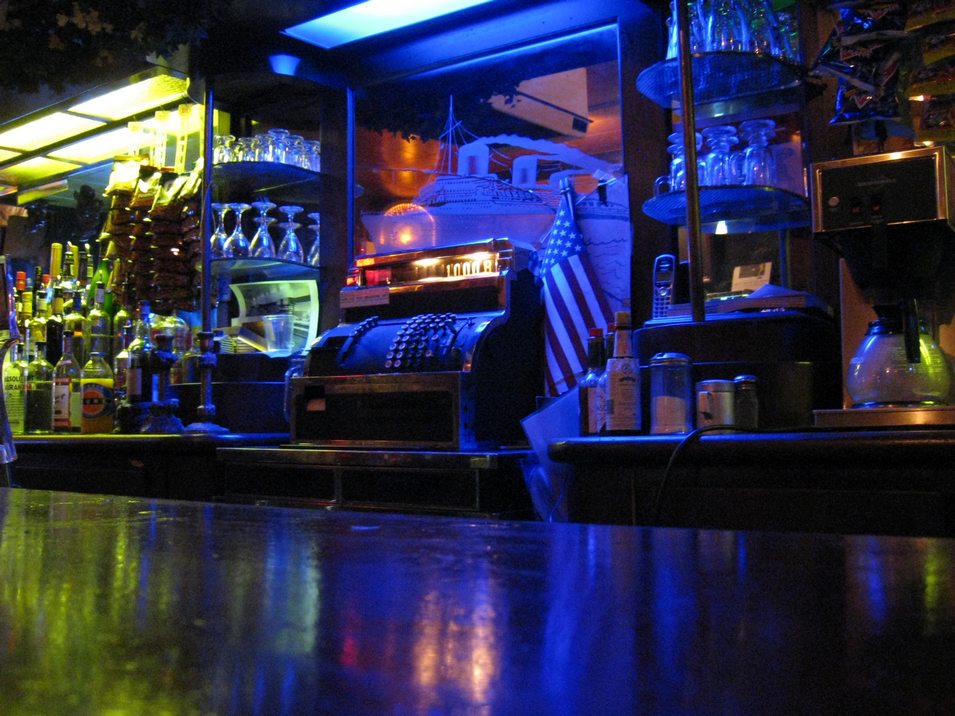 My first visit to Simon’s followed stops at Hopleaf for an afternoon of ale experimentation, and Big Joe’s for turtle racing (you know, the usual type of night). I remember Simon’s as being a pretty cool pub, but couldn’t remember many of the details. “My God, I’m drunk,” appeared on my notepad, written by some nameless rapscallion with handwriting that looks strikingly similar to my own. At that point, I vowed to return to Simon’s and cursed Big Joe’s for conspiring to destroy my liver. I did return, during Andersonville’s Midsommarfest neighborhood festival. This visit not only allowed me to become intimate with Simon’s but also featured rock climbing, consumption of Swedish meatballs on top of pancakes with lingonberry jam, and my thorough enjoyment of the cover band Mr. Blotto that features a keyboardist that does an impressive version of Harry Carey rapping. The bands aren’t really any different from any other neighborhood festival that takes place during summer, except for a stage that hosts mainly Swedish acts, but they are all still a blast. Overall, I highly recommend Midsommarfest, which is held every year in early June, and, of course, an obligatory visit to Simon’s. Just take care not to drink too much glögg and knock over the maypole.
My first visit to Simon’s followed stops at Hopleaf for an afternoon of ale experimentation, and Big Joe’s for turtle racing (you know, the usual type of night). I remember Simon’s as being a pretty cool pub, but couldn’t remember many of the details. “My God, I’m drunk,” appeared on my notepad, written by some nameless rapscallion with handwriting that looks strikingly similar to my own. At that point, I vowed to return to Simon’s and cursed Big Joe’s for conspiring to destroy my liver. I did return, during Andersonville’s Midsommarfest neighborhood festival. This visit not only allowed me to become intimate with Simon’s but also featured rock climbing, consumption of Swedish meatballs on top of pancakes with lingonberry jam, and my thorough enjoyment of the cover band Mr. Blotto that features a keyboardist that does an impressive version of Harry Carey rapping. The bands aren’t really any different from any other neighborhood festival that takes place during summer, except for a stage that hosts mainly Swedish acts, but they are all still a blast. Overall, I highly recommend Midsommarfest, which is held every year in early June, and, of course, an obligatory visit to Simon’s. Just take care not to drink too much glögg and knock over the maypole.
This Paragraph is Not About Japanese Log Rolling
The stories, the crowd and the neighborhood atmosphere at Simon’s are hard to beat. If you can’t make Midsommarfest, head there anytime of year, particularly when the weather is cold, so that you can be warmed with glögg, the fireplace and good conversation with the natives, young and old alike. Because of this, Simon’s continues to be a bridge between the old Andersonville, with its working class Swedes whose families have since moved out to the suburbs, and the hipper potpourri of folks that have since moved in. For more information, check out the Simon’s Tavern website. Skål!
“There’s a compelling, shabby opulence here — from the wood paneling to the bulletproof room where the original owner cashed paychecks for his friends.”
[back to the Chicago Bar Project]
